What should be a pleasant summer evening is interrupted by a series of ominous flashes in the night sky – the sure sign of a fleet dropping out of FTL at combat speed. Massive, spinal-mounted laser cannons roar to life, reaching out across the void to tear open armored hulls from miles away, followed by the rhythmic pulsing of mass drivers pounding away in intricately-calculated volleys thrown at near-relativistic speeds. Amidst the carnage, smaller craft dive into the atmosphere, their heat-resistant plating glowing white as they desperately try to avoid incoming anti-air fire long enough to disgorge their cargo of dropships to take control of the cities below. And all the while, the opposing fleets draw closer, splitting their attention between jockeying for position in orbit and clearing a path for their drop assets to take control of the critical infrastructure they’ll need to win the day.
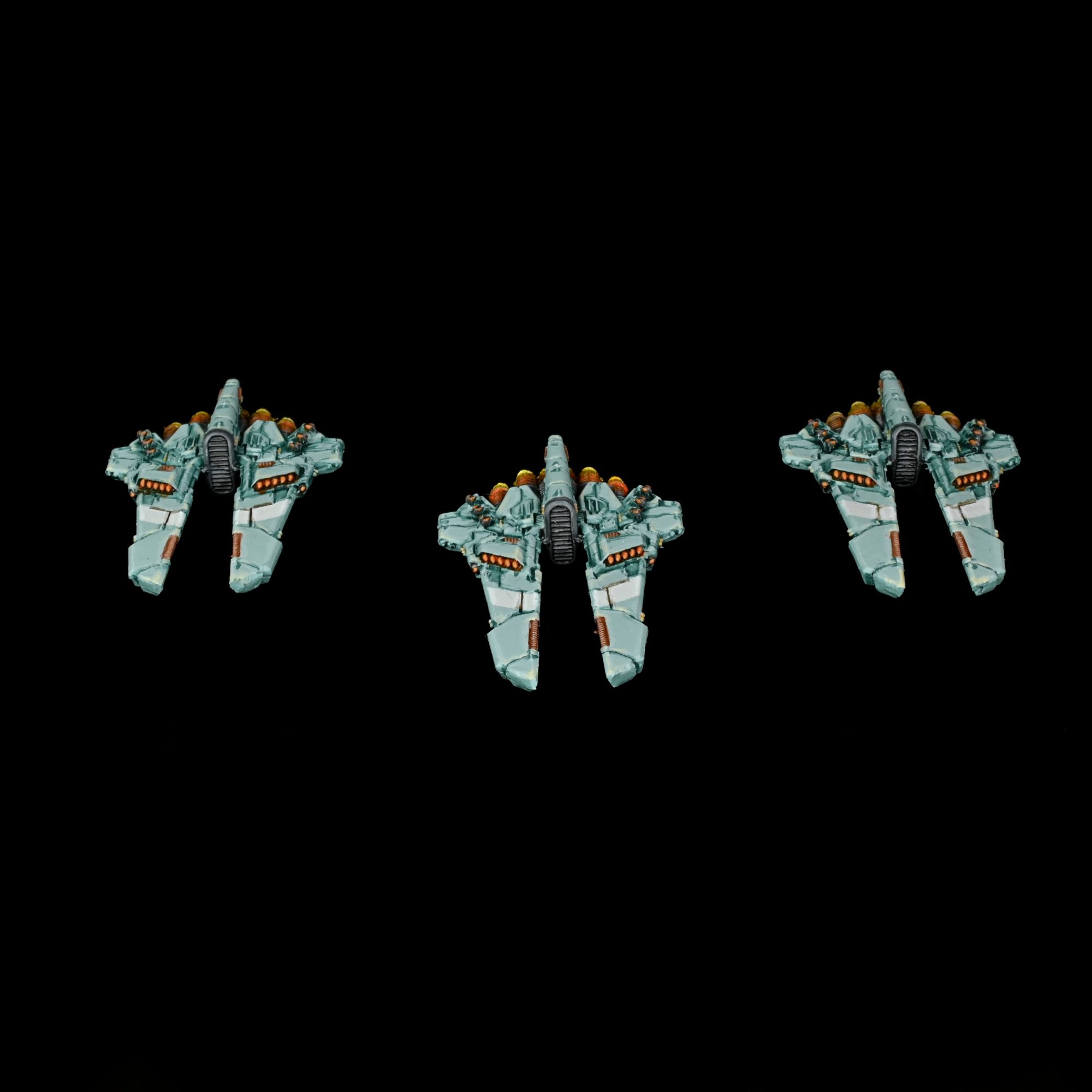
If this sounds like the sort of game you’d like to play, you’re in luck – TTCombat’s Dropfleet Commander provides an excellent vehicle to tell stories like this with a slick and easy-to-learn ruleset that maintains a remarkable amount of tactical depth.
So what is this game, anyway?
Dropfleet Commander is a sci-fi fleet game set in a universe where humanity is on the brink of extinction. Earth has been conquered by the alien Scourge, and the surviving humans have either gone into hiding or fled to the outskirts of the galaxy to regroup and rearm in an effort to take back their home. In the midst of this conflict, a splinter of humanity calling themselves the Post-Human Republic has joined the fray, though their interests don’t necessarily align with the rest of humanity’s. And to make things just a bit more complicated, the Shaltari, another alien race whose motivations are completely inscrutable, are doing their thing as well.
In game terms, you’ll command a decent-sized fleet of ships in a battle set in orbit around one of the many worlds in conflict in the setting. Unlike many fleet games, Dropfleet is centered around objective-based play from the outset, and you’ll need to bring troop landers and dropships to deliver ground assets to the various terrestrial and spaceborne facilities you’ll be fighting over during a game.
Why should I get into this game?
- Because you liked Battlefleet Gothic. Andy Chambers, one of the original authors of BFG, also developed Dropfleet Commander, and in lots of ways DFC is a modernised version of the much-beloved Games Workshop classic (and one that Boon and Condit won’t shut up about). Obviously the setting is different, but if you loved BFG you’ll find a lot of the same notes are hit with this game.
- Because you want to play a space fleet game. There just aren’t many, is the sad truth, but luckily Dropfleet is genuinely a great one. It feels much more like a fleet experience than something like Star Wars Armada, with quite a lot more ships on the table. The focus on dropping troops on the ground, the orbital mechanics and the overall structure of the objectives makes it a really engaging tactical experience. There’s a good level of crunch to the game too – the mechanics are interesting and involving, but not too granular or overwhelming. You can absolutely get lost in list building and theorycrafting, but you can also learn the game in an afternoon. And once you hit the table, you’ll find that you can generally play pretty smoothly without having to constantly reference tables or other arcane rules.
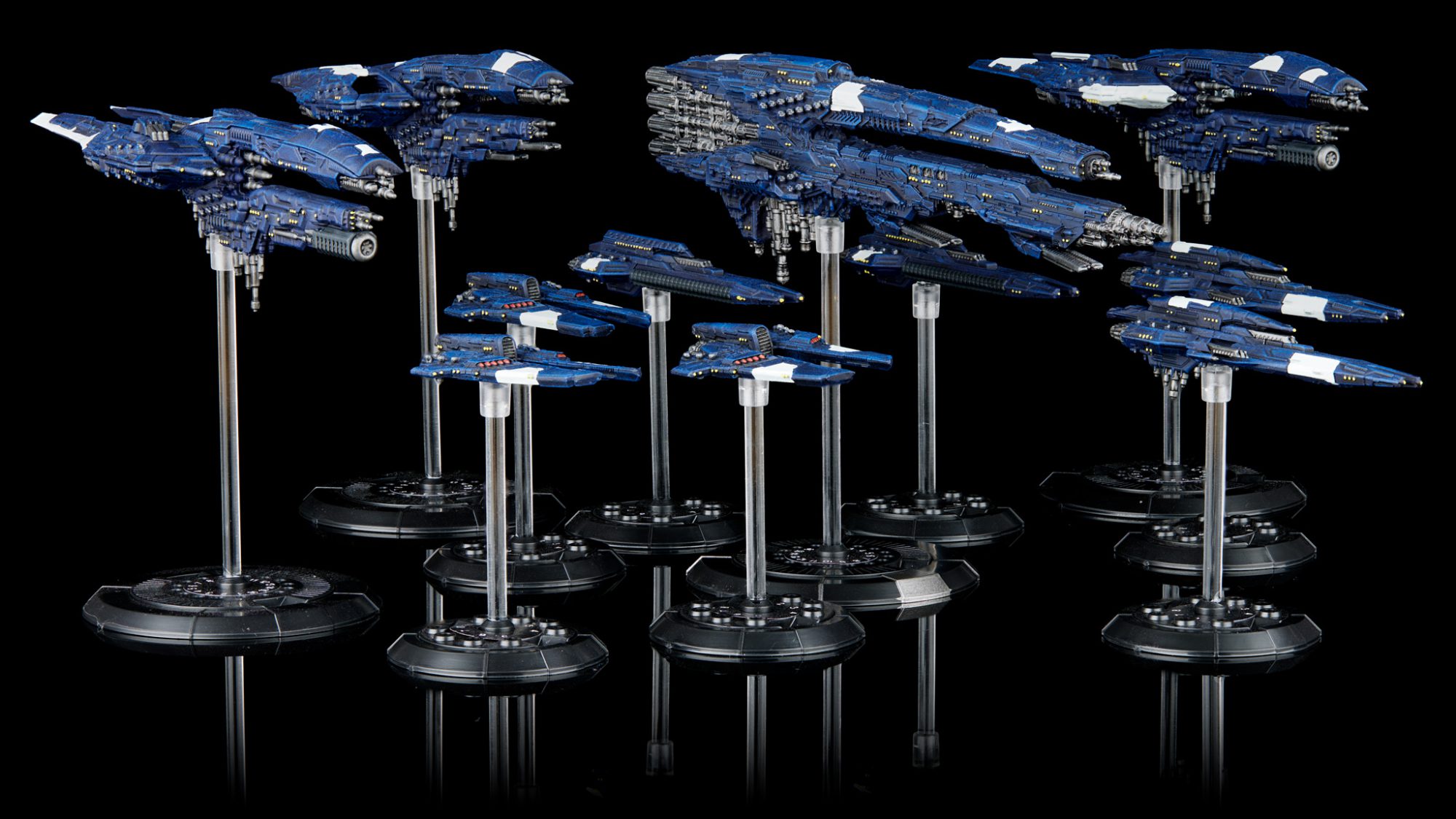
- Because have you seen these spaceships, goddamn. Look, the game is great, there’s no getting away from that, but even if there wasn’t a game many of us in the Goonhammer Offices would probably still be buying some of these spaceships just to paint and display. What’s fantastic is how many different aesthetics the game manages to cover without feeling disjointed. All the fleets look like they could believably be in the same universe, but they all look incredibly different.
Wait, I thought this game was dead?
Well, fortunately, you were wrong. It’s changed ownership since the original release, having moved from Hawk Wargames to TTCombat, who have done an amazing job in keeping up support for the game and offer a wide variety of ships and accessories on their website. They’ve kept up production of hard plastic kits for the cruisers and frigates, with resin options for just about everything else.
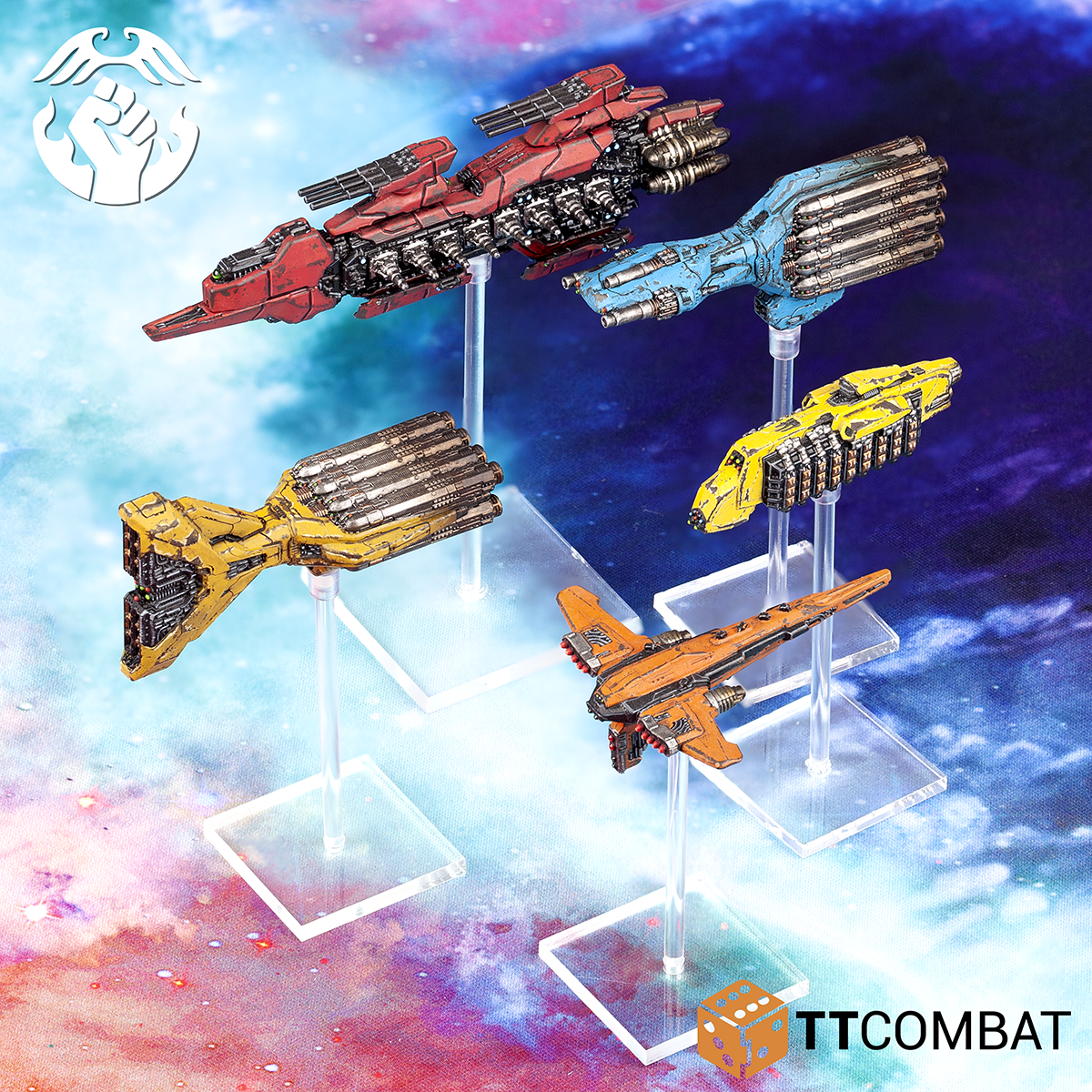
They’re not just keeping the existing game in print, though – within the past month, they’ve released a whole new class of ships with two loadouts per faction, and have even taken a balance pass through the various rosters to rein in some of the more remarkably powerful options. All told, they’re taking a serious swing at keeping this game supported for the existing fanbase, and have pulled together some incredible resources to help new players jump in and hit the ground running.
I’m sold. What do I need to get started?
Getting into Dropfleet is pretty easy as miniatures games go. Before your first game, you’ll need to pull together the following:
- A Fleet – TTCombat sells starter fleets on their website for 40 GBP, and shipping to customers in the US or UK is reasonable. Each of the factions’ starter sets comes with 3 Cruisers and 4 Frigates, which can be built to roughly a 500-point fleet in any number of combinations. If you’re gaming on a budget, this is an excellent choice to either start or expand a fleet, as you save 5 GBP over buying the Frigate and Cruiser boxes separately, and get a free Cruiser to boot.
- Alternatively, you could look at the Battlefleet boxes, which sell for 100 GBP. These are a bit more expensive, but they contain two full starter sets, a couple of Corvettes to hunt down opposing landers, and a resin Battlecruiser you can field in larger games. You’ll also get your faction’s strategy deck, which won’t be needed for your first game, but is a must-buy if you decide to play more. This box is a solid value – in addition to the value from the two starter sets, the Corvettes alone retail for 20 GBP, making up the difference there. In other words, the Battlecruiser and cards are effectively free.
- Finally, if you’ve got a friend who wants to try the game, you could look at the 2-Player Starter box. At 65 GBP, this is the best value way to get into the game, offering both a UCM and Scourge starter set, a playmat, the Battle for Earth book (itself a 25 GBP value at retail), and some tokens and other stuff that’s useful for playing the game. If you can find someone to split this set with you, the 2-Player Starter is our recommended entry point to the game.
- Dice, rulers, and other gaming accessories – DFC uses d6s and measures in inches, so the stuff you’ve got lying around for your other games will work fine here. It’s also a bit friendlier with measurement as the models are all on flight stands, making it a bit easier to get chunkier tape measures into a position where you can actually measure distances without having to contort your neck or tie the tape into knots.
- There is one major hiccup here, though: the core rulebook is near impossible to find, and has been for quite some time. Thankfully, you can download the rules from TTCombat’s website for free, but if you wanted the lore pages or just something in print to reference while you’re playing, you’re unfortunately out of luck.
- An accessory you’ll want eventually but won’t need to start is your faction’s strategy deck. These add a deck of tricks unique to your faction sort of like stratagems in 40k, and really help add some flavor to the various factions. They’re definitely an “add-on,” though, and your first couple of games will be fine without it.
- Play space – Tournament play is generally on a 4’x4’ space, but the game recommends a 3’x4’ board for your first game. In our experience, the 4’x4’ works fine at all game sizes but the largest, but the 3’x4’ area is a better fit for many kitchen tables
- One thing you won’t need here is a lot of terrain – while games of Dropfleet Commander do need terrain to represent the city centers you’re fighting over and the asteroid and debris fields that will be getting in the way, most of it needs to be flat to the table so that they don’t get in the way if you decide to fly your models into or over them. Thankfully, the starter set comes with a wonderful selection of cardboard cut-outs showing debris fields, asteroids, and space stations, so you’ll have plenty to choose from to get your first game going.
- An opponent – Grab a friend, paint your fleets, and get ready for action!
Which fleet should I play?
There are five different factions in Dropfleet Commander, each of which lends itself to a style of gameplay as unique and diverse as their models’ aesthetic. While the number one rule of choosing your first army – paint what you think looks cool, because while rules are ephemeral, plastic is eternal – applies here as well as in any game, it can be helpful to get a sense for how the various factions play on the tabletop before your first game. We’ll be going into these in more depth in future articles, but for now we’ve got the Greatest Hits of each faction.
United Colonies of Mankind (UCM)
The UCM are the human refugees who fled to the outskirts of the galaxy and devoted their time, effort, and resources towards the Reconquest, a grand plan to take back from the alien Scourge what rightfully belongs to humanity. These ships are purpose built for lightning-fast offensive actions, dropping in from deep space and moving to make planetfall at key strategic locations while supported by a broad array of powerful weaponry.
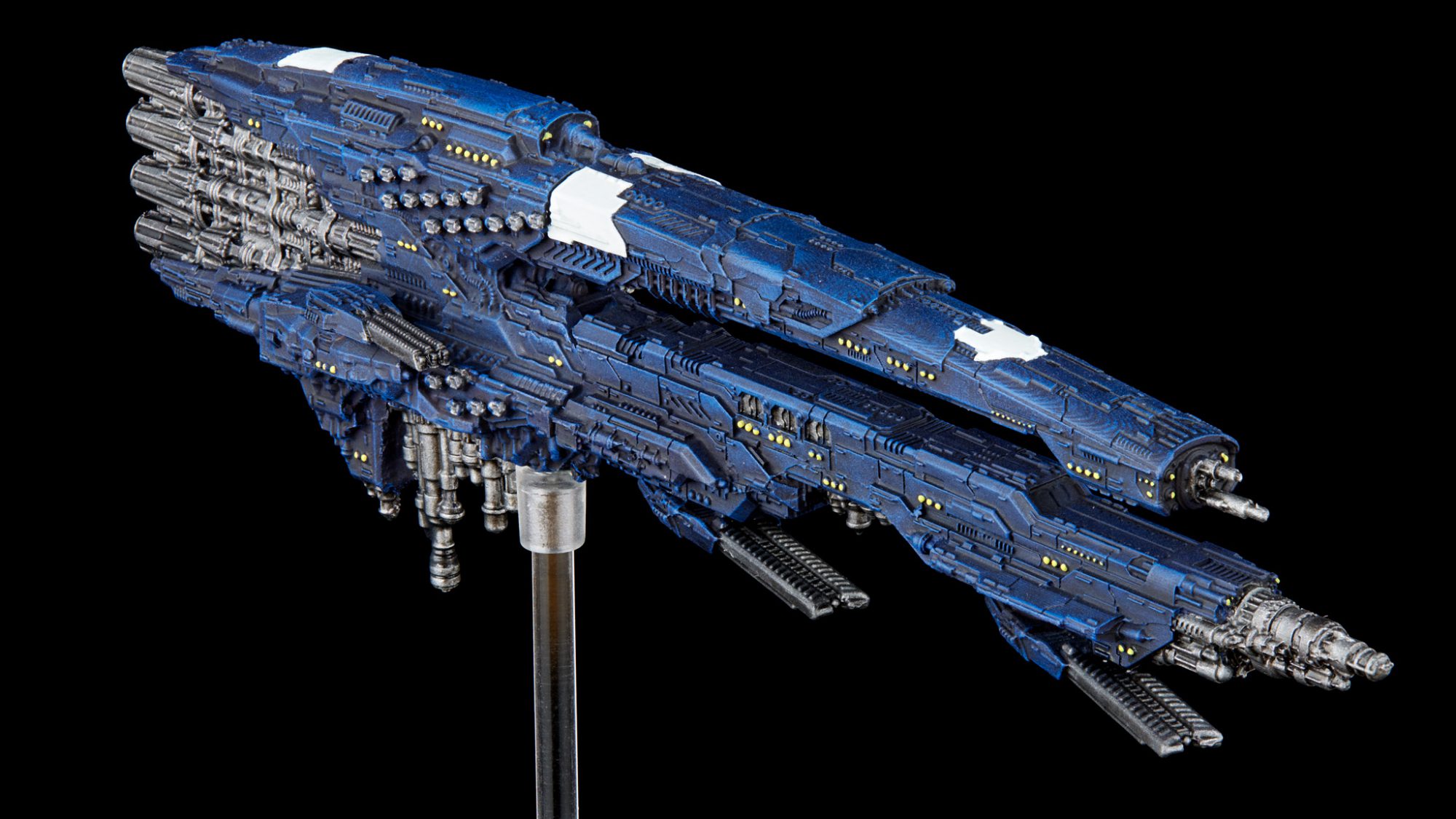
Visually, UCM ships have a more “hard sci-fi” aesthetic than many games in this space, sporting lots of antennae and festooned with turrets, point-defense emplacements, and visible weaponry. Gameplay-wise, the UCM has a broad variety of useful tricks mounted on reasonably tough ships. They tend to have fairly forgiving firing arcs that allow them to bring most of their guns to bear in nearly any situation, even if they won’t be able to put out as many shots as another faction in their element.
The UCM fleet lends itself to a tactically interesting, if unforgiving, combat doctrine, which focuses on taking out key targets in early turns, then mopping up the remainder once you’ve gotten in close. The flipside of this is that they’re not very forgiving of mistakes: if you’re not able to seize control of the pace of the game early, you’re going to have trouble catching up to the more specialized fleets of the other factions.
Scourge
The Scourge are a race of alien invaders who have conquered nearly all of humanity’s prior holdings, including Earth itself. They’re not even content with just taking worlds, either: the Scourge entities are parasites who burrow into and take over other living beings, something that has created no small amount of consternation among humanity.
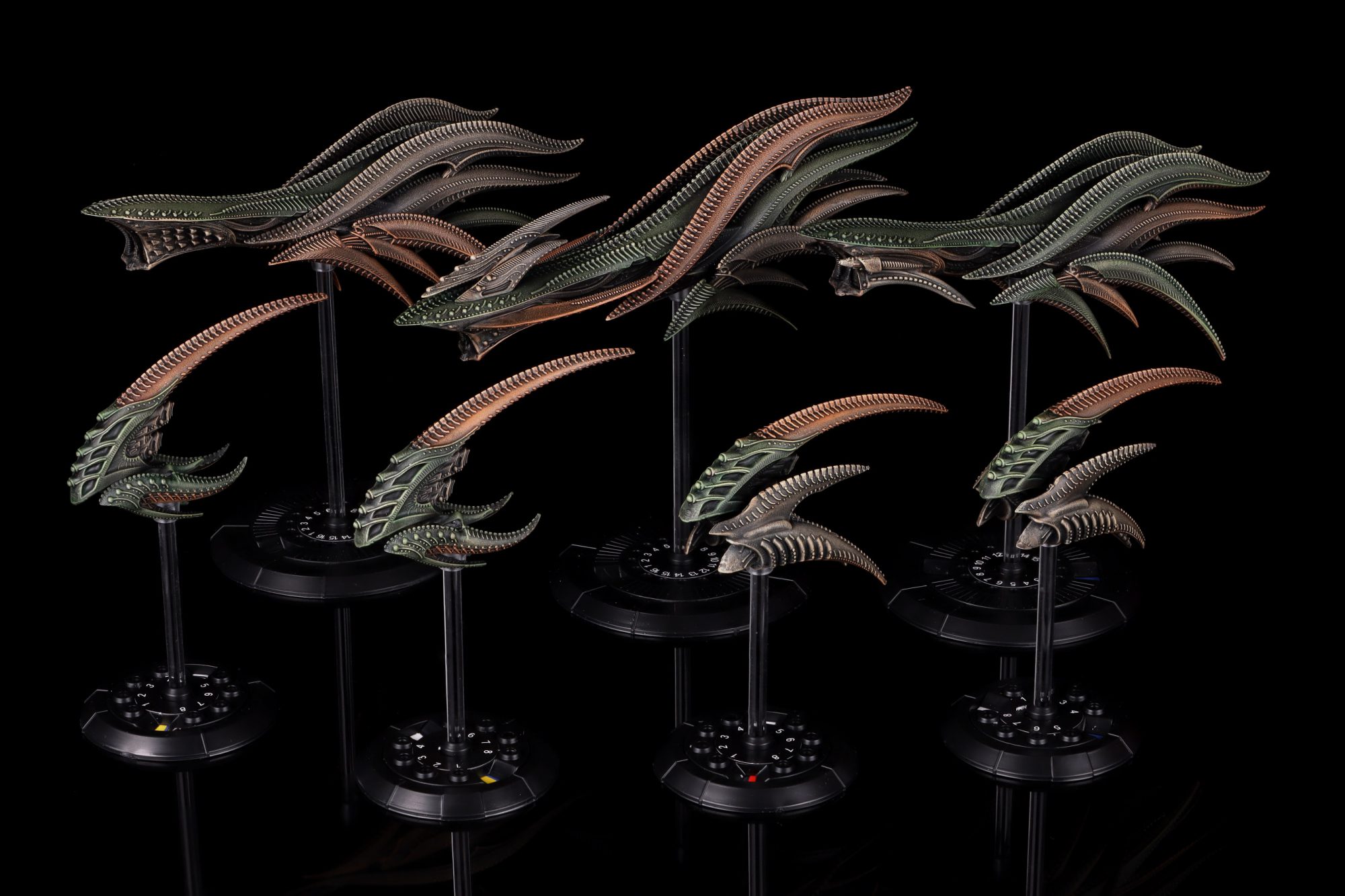
Scourge ships are organic-looking, with lots of curves and tendrils and swooping bits hanging off of them, emphasizing the truly alien nature of this interstellar threat. Their weapons focus on attacking at close range, featuring a lot of guns with the Scald rule, which makes enemy armor less effective the closer you are.
If you want to get aggressive and fly right up next to the enemy’s ships before hosing them down with some kind of weird alien goo that melts clean through their armor, you could do worse than the Scourge.
Post-Human Republic
Prior to the Scourge invasion, an alien being appeared before humanity, warning them of the incoming threat and offering safe haven to anyone willing to leave their homes and travel with it. Most of humanity declined, but those who travelled have come back as the Post-Human Republic. The sleek styling of their ships’ armor belies incredible toughness and some of the most potent weaponry you’ll find in the game.
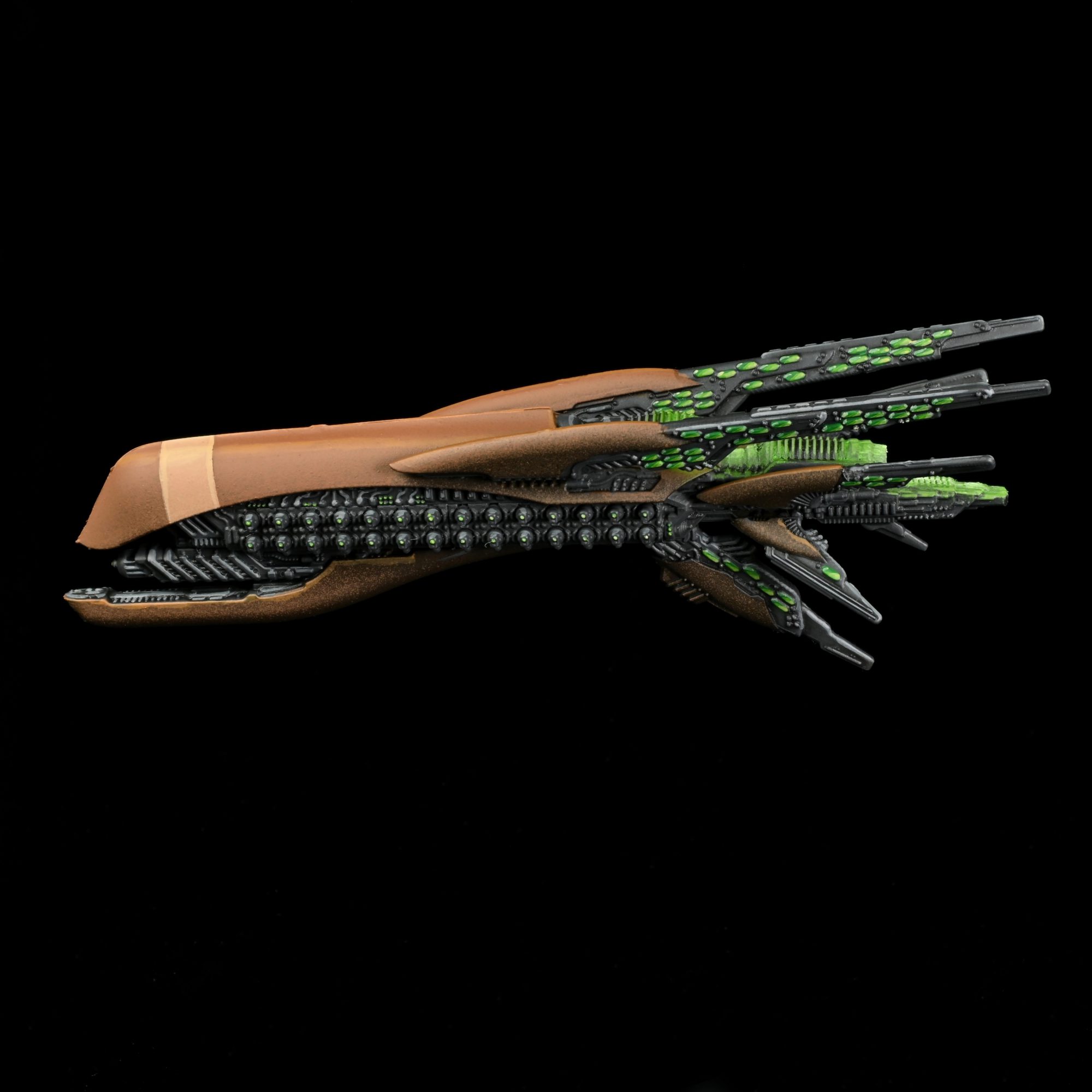
The PHR have a very futuristic look, with lots of large armor panels, sleek lines, and styling that looks vaguely human, if it was viewed through a funhouse lens made by a millennia-old alien intelligence. Their ships are tough as nails and mount weapons that throw out ludicrous numbers of dice, but tend to have most (or all) of those weapons mounted so they can only fire into broadsides.
As a result, the PHR wind up wanting to brawl at close- to mid-range where they can potentially fire out of both sides of their ships into different targets. And while they’re in there, their excellent bombers will make short work of any craft that doesn’t have enough point defense to fend them off. PHR vessels are generally more than a match for other factions’ ships of equivalent tonnage, so long as they’re able to bring their weapons to bear.
Shaltari Tribes
The Shaltari are an ancient alien civilization with phenomenally advanced technology who are definitely up to something – though what exactly their goals might be is more or less a mystery to the other factions. They’re immortal (or might as well be), and mount weapons and defensive systems on their craft that no other faction can hope to match.
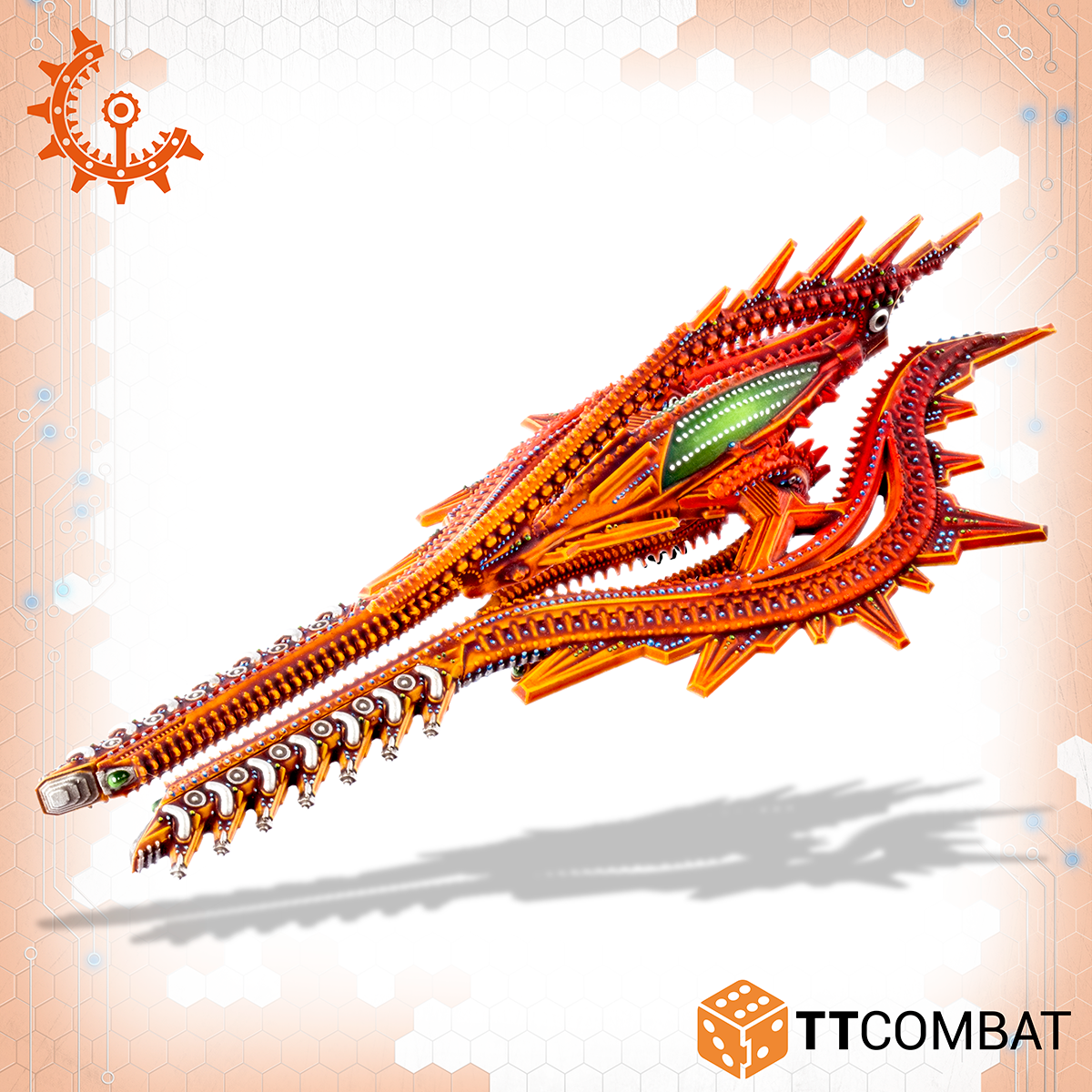
Their ships are definitely unusual, and visually won’t appeal to everyone. Those who like them, though, will find a nice variety of soft curves interrupted by large weapons and other systems protruding aggressively from within. On the table, they leverage their impressive technology to fire from ranges other factions can’t compete with, with most of their fleet sporting Scan ranges in excess of 14”.
Fortunately for their opponents, their ships are held together with tissue paper and prayer, though they do tend to have lower signatures. Unfortunately for their opponents, when enemies get too close, they can activate shields, massively increasing their ships’ Signature values in exchange for a 4+ Passive Countermeasures save – the DFC equivalent of an invulnerable save in 40k. Add to this the fact that they don’t use dropships, instead opting to teleport their ground troops into position, and you’ve got a force that can be incredibly frustrating to play against, so long as it doesn’t completely fold first.
Resistance
The UCM aren’t the only human faction in play here – a few of the humans who weren’t able to escape the Core Worlds when the Scourge invaded have managed to survive, and have mounted a desperate defense using whatever they can get their hands on.
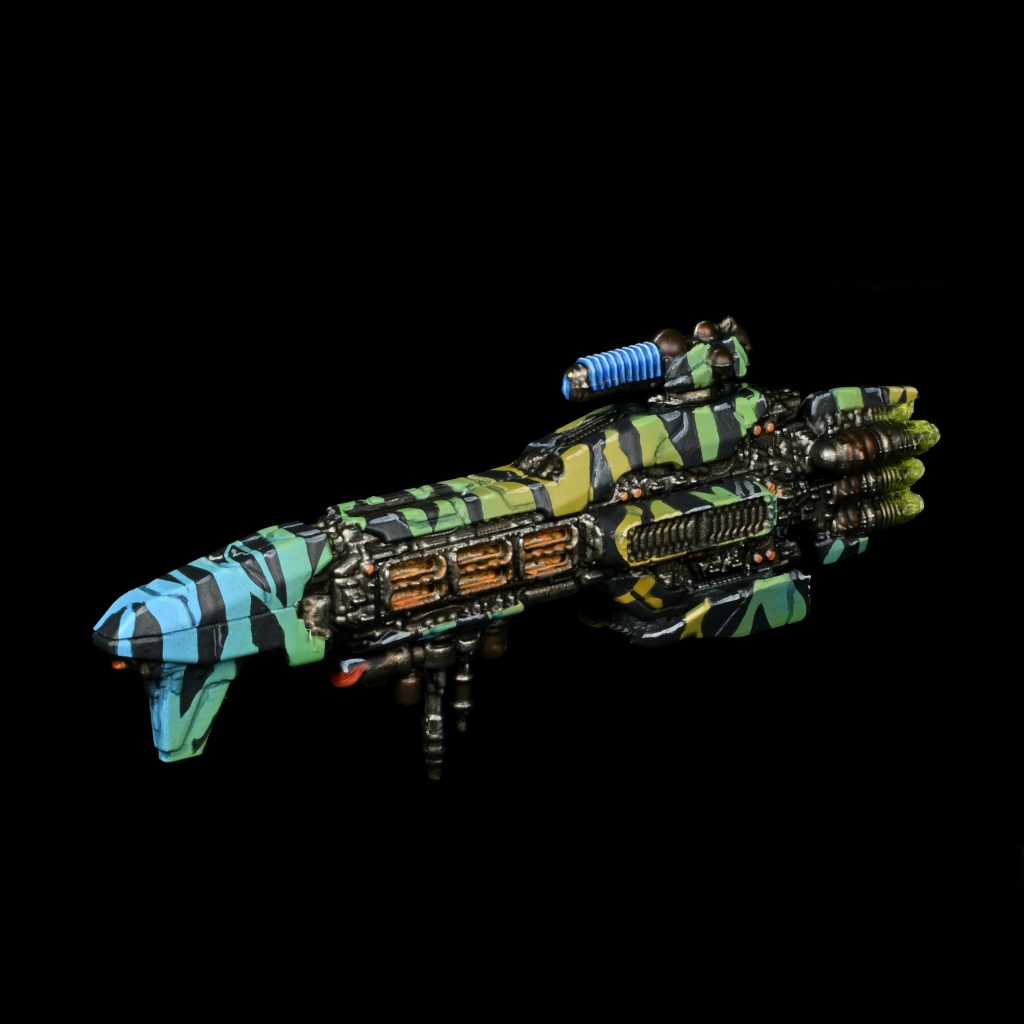
Visually, Resistance ships are a mixed bag, and the kits are extremely flexible in how they can be built. Each model in the basic Cruiser and Destroyer starter set can be built in hundreds of different configurations, and the larger ships come with even more options to choose from. The kits lend themselves handily to whatever theme you want your fleet to have, from a scrappy resistance fleet pulled together from the system defense fleets of a particular planet, to the rag-tag survivors of the Vega Scrapfleets, to the sleek and hyper-advanced battlefleets fielded by the Kalium Cabal.
From a rules perspective, Resistance fleets consist of a set of core units that can be outfitted however you like with a system of modular hardpoints backed up by specialist ships with fixed loadouts that bring some of the weirdest weapons in the game to bear – think virus-filled torpedos and cannons that run so hot that they can literally melt the armor off of the ship they’re mounted on. The sheer number of options here can be overwhelming to try to get your head around, but also present a number of strategic options that other factions have difficulty replicating.
How do I play?
Dropfleet is focused around trying to take and hold key locations on a planet’s surface (sectors in clusters), as well as any major orbital structures (space stations and moons). You and your opponent will be bringing your fleets on screaming out of the void to try and drop down to lower orbits and launch ground forces into the right places, while fighting for dominance in the space above.
If you want to seize victory, then here are the key things to remember:
- Drop is what counts. Almost every mission scores based on how many troops you manage to get on the ground to hold sectors and clusters. You might score some points for dominating areas of the table in space, or taking out enemy ships, but 99% of the time the thing that matters most is how much stuff you can drop onto the planet below. Your troopships and strike carriers are what win you the day, and playing tactically to get them where they need to be and protecting them is key.
- Momentum and firing arcs demand your attention. Your ships will, bar some special orders that are going to cause other issues, keep going forwards when you activate them. How much you can turn them is also often limited, so making sure that you bring them on in the right place facing the right way, and making the most of your turns is absolutely vital. You’ll need to try and anticipate where your opponent is going to be, and make the most of the advantages you have in your firing arcs and maneuver.
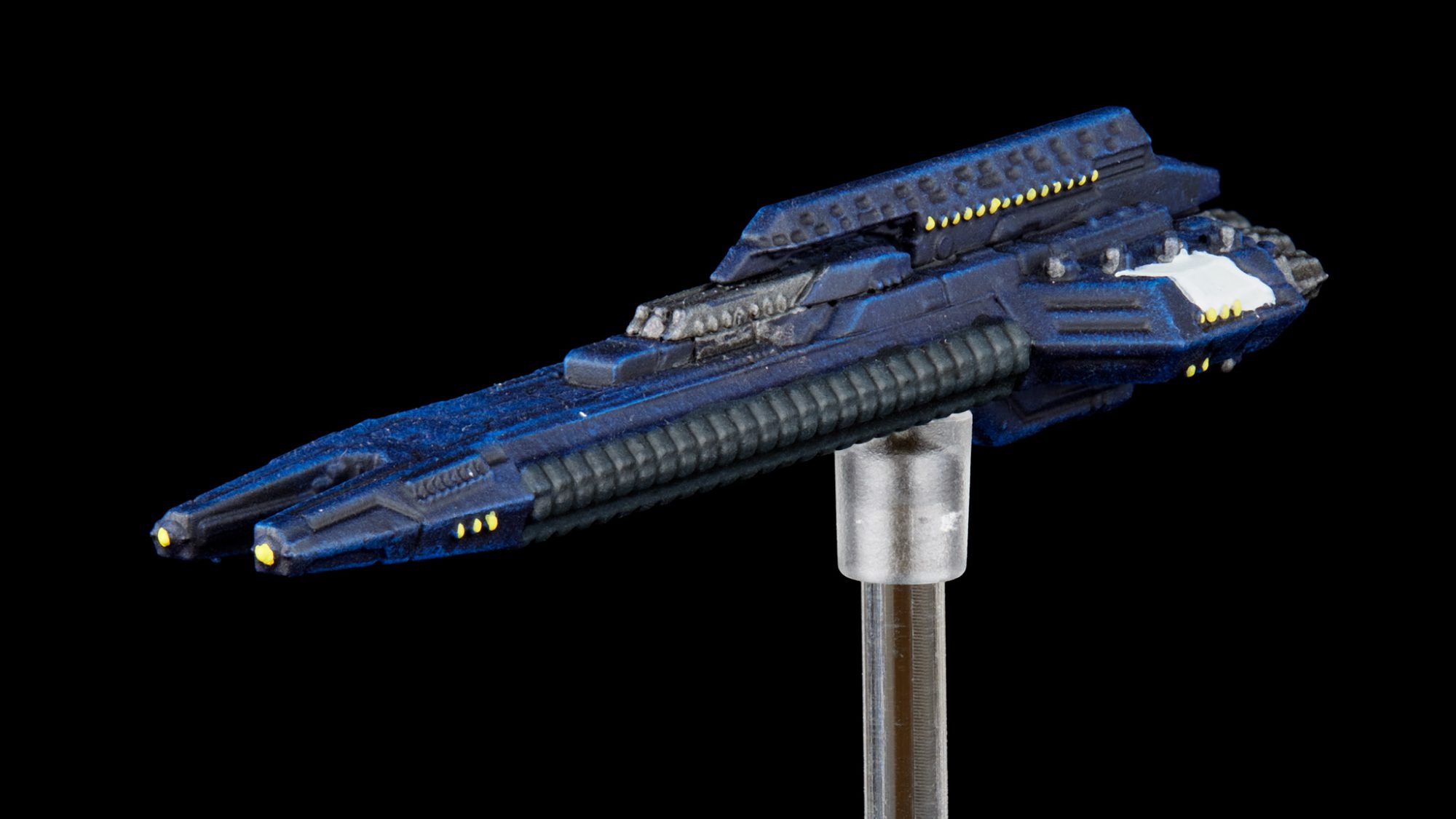
- You can shoot at anything you can see. It’s space, the barrier isn’t the range of your weapons – it’s the range of your scanners, and how easily you can target things. In the game this is represented by your ships’ scan stat, which indicates how far their scanners can stretch, enemy ship signatures, which adds to your scan when you’re targeting them, and spikes. Signature spikes happen when you issue special orders, launch assets or get lit up by enemy active scans or certain weapons. Bringing your signature under control means it’s harder for your opponent to get you in range, and being lit up like a christmas tree almost always means a ship is going to get a serious beating.
- Apply the right force in the right places. No ship can take on everything in the game – even the dreadnoughts and battleships that can dominate whole areas of the table are vulnerable to one thing or another. Working out what your ships can take on, and what they can’t, is absolutely essential. Learning what your opponent’s ships can do, understanding what their stats mean they’re going to do well against, and exploiting weaknesses is how you’ll rip through them. Lots of ships in DFC are specialist vessels, designed to do one thing really well, but that means they’re often vulnerable to other approaches. Other ships might be more generalist, but struggle when fighting against a true specialist in any particular area.
- Control the board. It’s easy to see the handful of ships spread out across the table and feel like there’s lots of empty space, but in truth every ship projects power and vulnerability in a bubble around it. Its signature and scan, the range at which its weapons are best used, and the range of any launch assets it can throw out are all aspects of the presence it has on the board. Learning to see the board as this blending mesh of spheres of influence and threat, and working out how you can dominate as much of the table as possible while leaving yourself as well protected as you can is really important.
Full Speed Ahead
In future articles, we’ll be taking a look not only at how to play the game, but some of the best ways to get into it. We’ll be looking at not only how to play and paint the various factions, but diving into how to build your lists and what various the various ships and their loadouts can do.
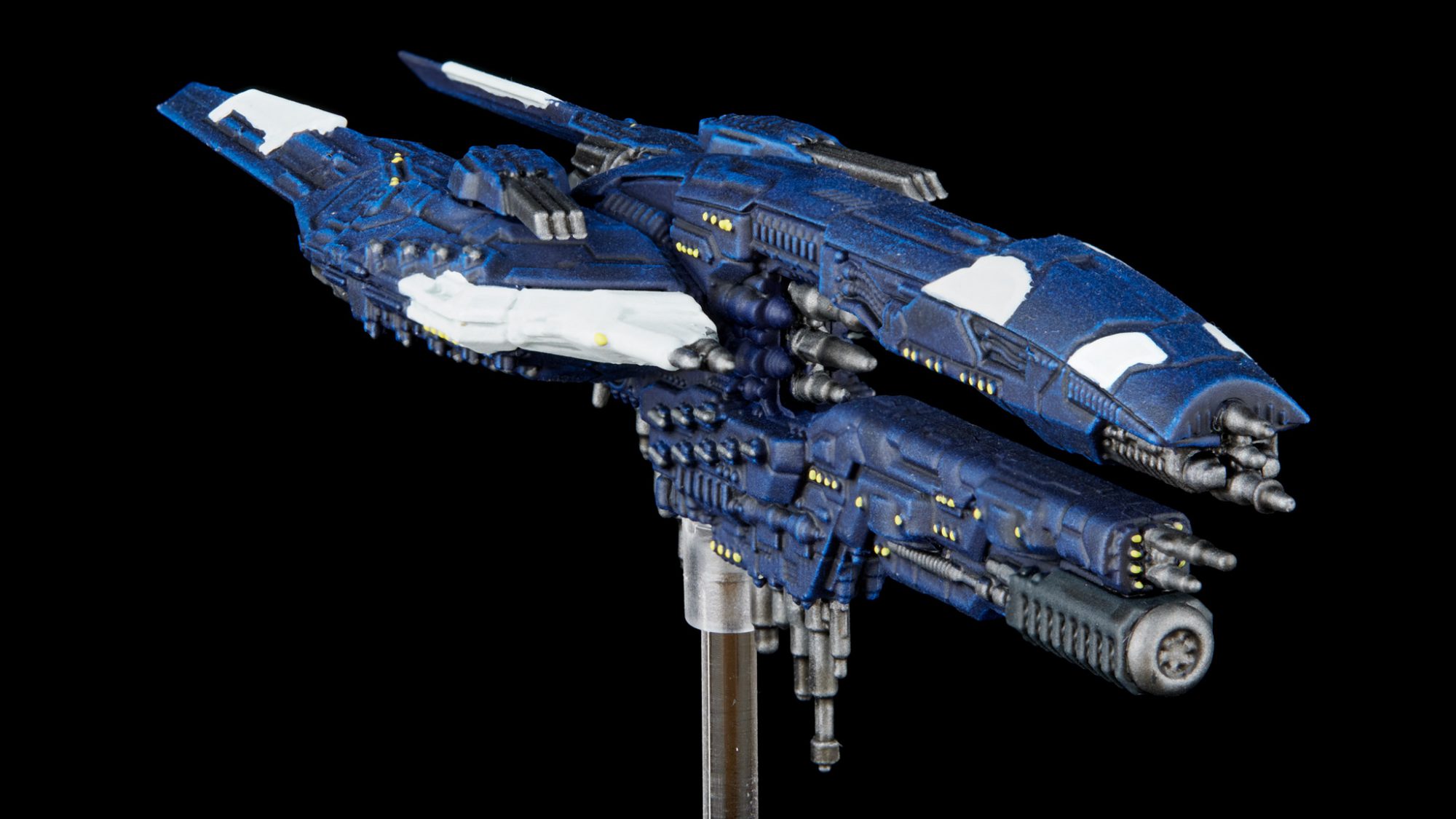
We’ll be taking up an alternating slot with Warlord Wednesdays here, so check back every two weeks for our latest article. We’ll start two weeks from now with a review of the 2-player starter set, and a quick battle report showing the sort of game you can expect to see with that set.


